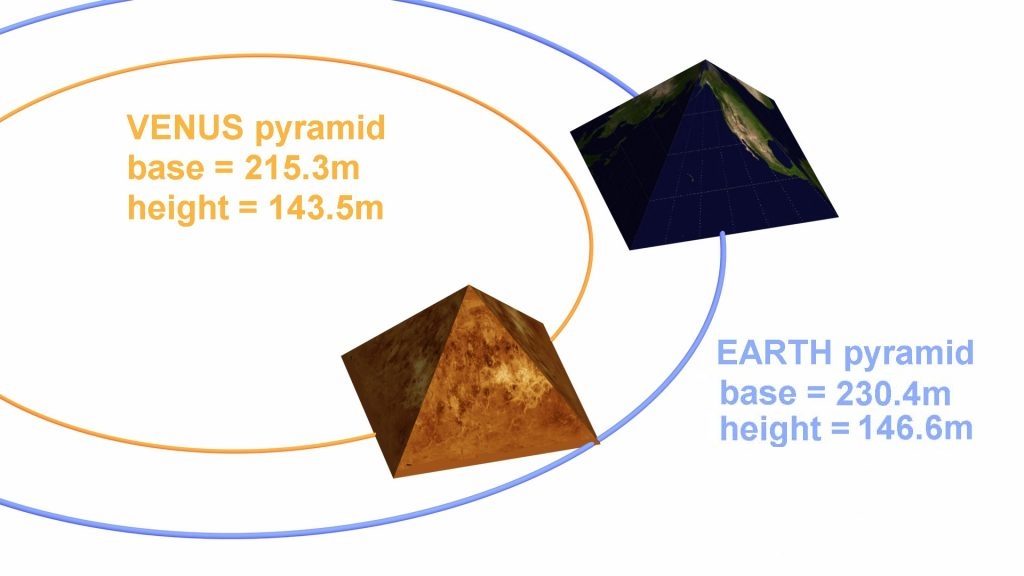In his book Magicians of the Gods, Graham Hancock suggests that an advanced civilisation existed in prehistory.
This civilisation had accurate knowledge regarding the size of our planet, and encoded this knowledge into the design of the Great Pyramid.
Their method of encoding is summarised in the article here.
A sphere can store one value, in its radius. A pyramid can store two values, in its base and in its height.
The Great Pyramid stores the value of the radius of the Earth redundantly in both base and height.
This highlights the accuracy found in the value and also specifies the constant of proportion to be used (in this case, K=43200).
The next planet towards the sun is Earth’s closest planetary neighbour, our sister world Venus.
When considering the second pyramid to represent the planet Venus, the same constant of proportion can be used.
The base of the Venus pyramid is 215.3m (411.2 cubits). The height of the Venus pyramid is 143.5m (274.1 cubits).
Using the formula for the volume of a pyramid these values yield a volume of 2.217×106m3. The volume of the Great Pyramid – the Earth pyramid – can be similarly calculated as 2.594×106m3.
The ratio of these values,  is
is  = 0.855.
= 0.855.
According to Wikipedia, the volume of the Earth is 1.083×1021m3 and the volume of Venus is 9.284×1020m3.
The ratio of these values,  is
is  = 0.857.
= 0.857.
These two ratios are remarkably close, less than half of one percent apart.
The Venus pyramid stands in volumetric proportion to the Earth pyramid, as planet Venus does to the planet Earth.
The upscaled version of the radius of Venus using the height would be K × HVENUS = 43200 × 143.5m = 6200km.
The upscaled version of the radius of Venus using the base would be K ×  = 43200 ×
= 43200 ×  = 5920km.
= 5920km.
These two values represent the outer bounds of the estimate: 6200km-5920km = 280km.
The average of these two values is (6200km+5920km)/2 = 6060km. The error range is divided evenly, resolving to 140km above or below the estimated value.
With the same method of encoding the Great Pyramid applied to the second pyramid, the builders declare the radius of Venus as being 6060±140km.
Our current estimate based on space age technology is 6052±1km.
Doug Keenan was born in Indiana and received his degree in electrical engineering from the Rose-Hulman Institute of Technology. For more than twenty years he enjoyed a career in the consumer electronics field and holds several patents including the multi-brand universal remote control. Doug is a computer programmer, botanist and entrepreneur, whose work now focuses on pyramids.






BIGSKYMAP.COM is Doug Keenan’s website.
Excellent information. I am reading John Michell’s “The Dimensions of Paradise” right now and this number heavy look at the ancients is right in that same wheelhouse. The 43200 number is no accident either, it fits with the multiples of 72 that Michell views as significant to the ancient numerology. So does the 144000 supposed facing stones on the Great Pyramid (or 144000 days of a Mayan baktun), as does the 864000 mile radius of the sun, and even the 1080 radius of the moon which Richard Heath correlates to the 108 royal mile distance from Lundy to Stonehenge (108 is also sacred to Buddhists). All very interesting stuff, clearly there where numerical patterns to all creation, as above so below, that the ancients saw on Earth and in the heavens.
Thank you for the kind and thoughtful comment. I agree the scaling factor is no accident. It has temporal connections as well.
It just dawned on me that my graphic has an error, the irony. Regarding the Great Pyramid the values of base and height are mislabeled, base is 230.4m and height is 146.6m. The rest of the math is not based on this graphic, it was created only for this article.
That makes sense about the graphic, I thought that might be the case when I read your article again to make sure I was looking at it right.
I also misquoted the radius of the sun to be 864000 miles when that is in fact the diameter, the radius is then 432,000 miles. Some other 432 oddities are the 432,000 year kali yuga, the 432hz tuning of “a” in ancient instruments, as well as the fact that 432 squared is a close approximation of the speed of light. I’m sure the more one digs into the matter the more it would be apparent that there are enough 432s and phenomena based on multiples of 72 to fill several books. There can be no doubt that the 43200 multiplier used in pyramid construction at Giza was not a coincidence.
ALL the ancient civilizations used a 12 hour day – 43200 secs per day.
Multiply that by the base of the Great Pyramid (1000 yards) gives the circumference of the Earth.
Note: ancient yards not British yards.
Your input is appreciated. I have not studied other ancient civilizations to that detail.
Graphic has been corrected, my thanks to the admins!